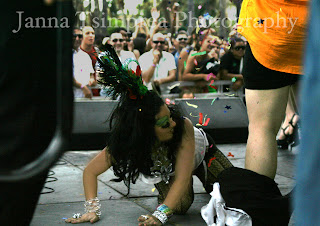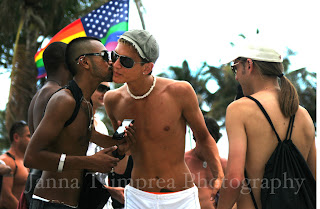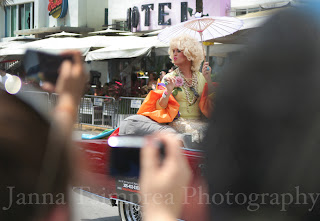Puffs of exhaust hung in the humid air as downtown Miami traffic stayed still. Elbows leaned on horns and pedestrians slinked around cars—people just trying to complete their days. Below the skyscrapers, a man in an orange shirt and a sign around his neck waved and smiled. He was accompanied by a few others standing beside him, splitting the hot frustration of traffic, stretching his arms up to hold another sign. Written in careful red marker, it read, “U R Awesome.”
Kemy Joseph, 24, has made it his mission to spread happiness around the community. Upon his graduation from the University of Miami, he launched U R Awesome Inc., a non-profit organization, to start a chain reaction of kindness in the world.
“People think I’m [giving hugs] for the girls or they think I lost a bet,” Joseph said. “When I explain I’m spreading kindness, some people get it and some people still say ‘what the heck?’”
Joseph started at his quest to feel good at the University of Miami, dispersing free hugs, high-fives and peaceful pounds. He became well-known among the college students for years, and later among the Miami community. To some, he’s just the random guy who was encouraging them on at the ING race. To others, he’s just a face that they’ve seen on the news. To the homeless community of Overtown, he is the man who raised thousands of articles of clothing, hot food and personal care kits and gave it all away to them.
Starting next week, he’s taking his mission across the world.
“Seeing so many things that are happening around the United States and around the world, kindness is needed now more than ever,” Joseph said. “It was like, alright, you have to do it right now, because the stars are coming together.”
Joseph launched the World Kindness Tour earlier this week in Key West. With nothing but a motorbike, a small bag, the trademark sign around his neck and arms for hugging, Joseph plans to weave his way north across the country and into Canada. He will be staying in North America this time around, but hopes to be able to travel the rest of the world in the future.
Along the way he will telling his story to people that he encounters—reminding them all not to forget what life is really all about. He has also sent in applications to go to schools across the country as a motivational speaker. Whether it is a smile or a hug, or doing a random act of kindness, Joseph reminds that that spirit is what’s most important.
“I have construction paper with me, so I’m making signs every day,” Joseph said. “The idea is that I’ll wear the free hugs sign on the front and then the sign of the day on the back. Construction paper won’t be that heavy to carry.”
He has not booked any hotels and doesn’t plan to. He is setting off on his red Genuine Buddy scooter plans to stay at the home of anyone willing to take him in for a night and maybe offer him a meal.
“So far, I’ve had a few couch-surfing hosts and they were complete strangers,” Joseph said. “They were great hosts and they gave me hope for the whole tour, that there’s a lot of great people who will let me go and just be a part of their house environment for a day or so.”
But in case he finds himself stuck without anywhere to stay, U R Awesome does have a bank account with some money and Joseph is asking for donations on his website and travel blog.
Joseph is planning on the tour to take about a year. “I’m hoping to be back with my family for Christmas,” he said.
“It's become obvious to me that he looks up to figures like Ghandi and Mother Teresa and tries to emulate them,” James Clinard, who has held up signs with Joseph during rush hour traffic, said. “He also makes a very strong effort to avoid all types of violence, profanity, and many things associated with that such as alcohol. He even goes to the extent of preoccupying himself when people in the room are watching mixed martial arts on television or playing a first person shooter game.”
Joseph’s younger years started with run-ins with the law and trouble back in his hometown of Homestead, FL. He says that those times inspired him to really do something more with his life.
“There have been situations when people haven’t been nice to me,” Joseph said. “And back in the day, your boy would’ve done something about it.”
“I’ve had a lot of people ask me if Kemy really was a bad boy,” Kenid Joseph, his older sister said. “And he really was. But it’s great seeing him grow and change. Today, he embodies everything he says.”
Eventually, the kindness that his mentors through high school had shown him began to encourage Joseph to change his path in life. “I don’t think I’d be here without kindness. I was on a very self destructive path when I was younger,” Joseph said.
Helping other teenagers that may be experiencing something similar is on U R Awesome’s agenda for the World Tour. Vice President of U R Awesome, Ruben Rodriguez, also known as Mr. Sunshine, spoke at Pinecrest High school earlier this month. Rodriguez heard about U R Awesome when dating Joseph’s sister and wanted to take on a leadership position.
“The speaking event was a phenomenal success and we’ve had a tremendous response,” he said. “Just check out my [Facebook] wall to see student responses.”
Students did indeed leave many comments and post many pictures to Rodriguez’s wall, with many thanks, anticipation for U R Awesome’s return and photos snapped with camera phones.
Alongside Joseph and Rodriguez, many of the leadership positions in U R Awesome Inc. are currently held by students at the University of Miami. Most of them met Joseph in the campus club Random Acts of Kindness, where he was club President. U R Awesome has similar initiatives as Random Acts of Kindness.
U R Awesome Inc. has sold or given away hundreds of t-shirts that are modeled after the inspirational signs Joseph has worn around his neck every day since September of 2008. These shirts share the same happy messages like “U R Unique,” “U R Amazing,” and of course, “U R Awesome.”
The shirt sales serve to raise money for the Great Giveaway. This charity event raised thousands of articles of clothing and so many boxes of pizza that they needed a Hummer to transport them. On the service day in Overtown, impoverished and homeless citizens of Miami could come and take anything that they needed. Because the shirts were sold to University of Miami students for $10, twice as much as they cost to make, U R Awesome was able to buy a second shirt for every one sold, and give a complimentary inspirational shirt to the event attendees.
Traveling with U R Awesome and not having a definite roof above his head is not completely new to Joseph. After the 2010 earthquake in Haiti, Joseph camped out in a tent in the middle of the University of Miami for weeks, raising money to fund a trip to Haiti. When he got there, he spread kindness, a helping hand, and hugs to the crestfallen citizens.
“We need everyone’s help to make the world a kinder place or change the world one kind act at a time,” Joseph said. “And you know, anybody will be able to help the Tour—even if they don’t specifically join us with the tour—they can help by just being kind to themselves, to others.”


